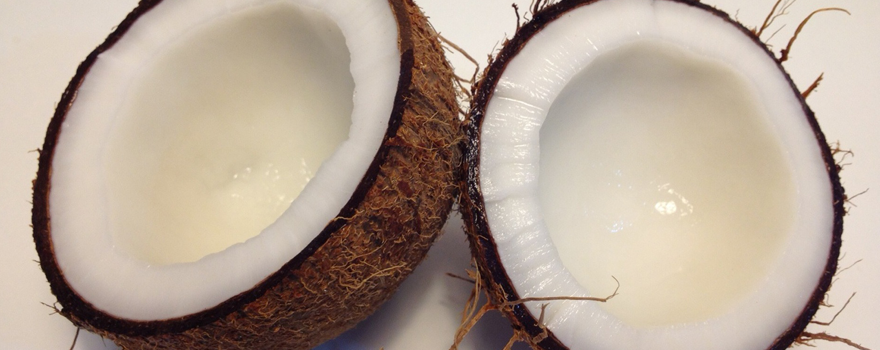
The coconut tree has been used by humans and their ancestors for at least 500,000 years. Of all the horticultural crops only coconut provides us with the resources to build a boat, sails and shelter, fill it with nutritious food, oil, milk, water, medicine, a high energy source of fuel to keep us warm, to cook with and a wide range of useful goods to sell.
The ancestral coconut palm grew on the northern coasts of Gondawana land fragments. It spawned a seed with a thick husk protecting the shell from mechanical shock after falling from up to 100ft offering a buoyancy that could enable the seed to drift on ocean currents for months until carried onto a distant shore, and germinate, consuming the stored energy contained inside the seed while it grew fronds capturing solar energy and put down deep roots to find the sweet water beneath sandy shore lines. A flexible trunk and ability to detach large fronds while protecting the heart of the tree meant an unparalleled ability to survive the tropical coasts violent storms.
As a food, crop, cultural and landscape icon protected and nurtured by millions of people who have experienced and weathered its unfair displacement over the these patient families are now best positioned to benefit from coconut returning as the worlds healthiest sustainable plant based edible oil.
At a time when concerns of agricultural productivity and global nutrition forms a central part of policy development for all countries, the coconut palm offers an opportunity for a viable alternative to unsustainable, harmful monoculture agricultural systems, GMO and climate change amplifiers.
Planted area for Coconut has not increased since the turn of the century, achieved by replanting in the same space vacated by a declining palm, now recycled for its timber to build a shelter or home. Zero corporatized disruption to biomass or peat soils. No clearing of rain forest. No displacement of local populations. A valuable, existing, in ground plant based resource of healthy nutrition and numerous downstream products.
The 19th C industrial revolution surge in demand for fats and oils by Europe and North America placed coconut centre stage as one of the original global trade commodities. The Tree of Life became, albeit briefly, the tree of economic life for western investors, traders and processors. Plantation establishment flourished and reached a peak in 1920’s.
An incredible decline in demand followed a series of extraordinary economic circumstances including global warfare, depression, mass-market manipulation and cynical misinformation by competing vegetable oils industries.
Throughout this period the coconut plantation survived due to its importance within the communities that farm it and now represents the example of sustainability in the production of healthy nutrition.
Coconuts modern history is one cataloged by war, depression, corrupt market manipulation and a deliberate distortion of facts.
When the world depression began in 1929 new plantation development ceased and never resumed. Military occupation during the war in the pacific (1941-1945) interrupted exports from large regional coconut country producers. The oil shortage was acute in the USA who responded with a huge research effort to boost local vegetable oil supply. Soybeans, previously used in paint formulations became large scale via intensive monoculture farming practice over millions of hectares in the mid west USA. By the end of WWII soybean had the potential and resources to capture much of the market share previously held by Coconut Oil.
Following the end of WWII, as coconut oils attempted to re-enter the western markets, an unrestrained marketing campaign was launched to convince consumers that soybean oil was healthy and coconut oil, along with dairy products, butter and other saturated animal saturated fats were not. As a result of this misinformation the coconut oil market share declined to a level too low to revitalize the pre war coconut industry of plantation scale production.
In the 1950’s the huge decline in food uses of coconut oil was attributed to the adoption of the “low fat diet”, birthed as a result of the orchestrated denigration of saturated fats by the commercial interests and promoters of unsaturated fats.
Aggressive marketing, political influencing, sidelining of unfavorable published research to their own vegetable oils in particular the dangers of Trans Fats continued to the late 1990’s.
Coconut, represented by small, scattered and developing economies were under resourced to mount an effective resistance to the powerful western vegetable oil industry.
In the 1960’s rapid expansion of high oil yielding varieties of oil palm in a corporatized ownership model resulted in the clearing of millions of hectares of virgin land in South East Asia, despite a global outcry against deforestation and the impact on climate change arising from another unwelcome intensification monoculture plantation model.
Today these same chemically intensive vegetable oil farming systems are regarded as unsustainable, outdated, harmful to the environment, public health and the communities that farm them.
Coconut on the other hand continues to represent organic sustainability, and community inclusiveness consistent with the globally recognised and supported UNDP Sustainable Development Goals.
In 2016, it has become clear that a diet low in fat has led to an epidemic of obesity and that the medium chain triglycerides that make up coconut oil and comprised of Lauric and Caprylic acids are a key resource to supporting healthy nutrition, antioxidant based skincare, immunity support, pathogens fighting and exciting new science around cancer beating Ketones.
Abridged and Credited to Mike Foale.
Leave a Reply

